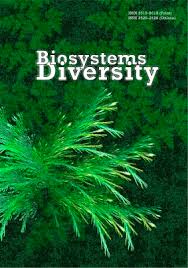Features of ecological differentiation of halophytic, steppe and petrophytic vegetation in the valley of the Liman Kuyalnik (Odesa Oblast)
Features of ecological differentiation of halophytic, steppe and petrophytic vegetation in the valley of the Liman Kuyalnik (Odesa Oblast)
Author(s): D.V. Dubyna, T.P. Dziuba, L.P. Vakarenko, A.A. Ennan, H.M. Shykhaleeva, H.M. KiriushkinaSubject(s): Environmental Geography, Evaluation research, Human Ecology, Environmental interactions
Published by: Дніпропетровський національний університет імені Олеся Гончара
Keywords: synphytoindication; DCA-ordination; Therosalicornietea; Festuco-Puccinellietea; Juncetea maritimi; Bolboschoenetea maritimi; Festuco-Brometea; Sedo-Scleranthetea;
Summary/Abstract: Assessment of key environmental factors that influence vegetation distribution and formation of plant communities is one of the most important challenges in modern phytocenology. Nowadays, several bioindication systems are applied to determine ecological specificity of plant communities and to establish the leading factors for their environmental differentiation. The system most widely used in Europe, that of H. Ellenberg, contains a numerical score on 6 ecological factors. On the example of vegetation of the valley of the Liman Kuyalnik, Y. Didukh developed the synphytoindication method based on evaluation of phytocenoses with respect to 12 ecological factors: 7 edaphic factors and 5 climatic factors; the method determines a more accurate and complete presentation of the analysis. In the valley of the Liman Kuyalnik (Odesa Oblast) the largest area is covered with halophytic and steppe vegetation. Halophytic vegetation (Therosalicornietea, Festuco-Puccinellietea classes, Juncetea maritimi, Bolboschoenetea maritimi) predominated in the shoreline areas of the valley, whereas steppe (Festuco-Brometea) and petrophytic (Sedo-Scleranthetea) vegetation dominated on the slope sites. With the application of DCA-ordination and synphytoindication methods it was established that distribution of plant communities in the hyper-space of the environmental conditions was most strongly correlated with edaphic factors, whereas microclimatic (light intensity) and climatic (thermo-regime) conditions had somewhat less influence on their differentiation.
Journal: Biosystems Diversity
- Issue Year: 27/2019
- Issue No: 3
- Page Range: 205-213
- Page Count: 9
- Language: English

